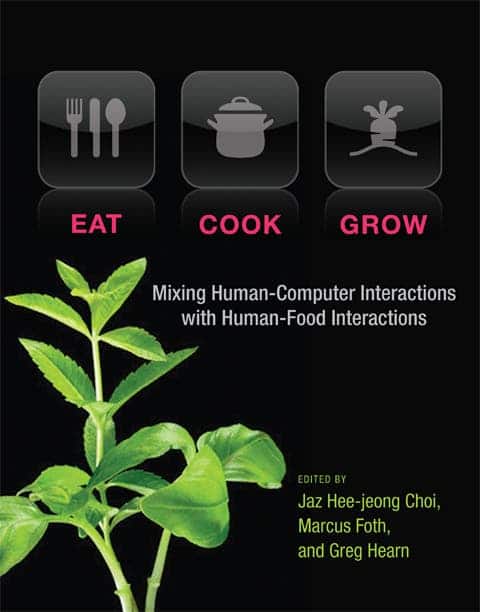“Eat, Cook, Grow: Mixing Human-Computer Interactions with Human-Food Interactions”
By Jaz Hee-jeong Choi (Editor), Marcus Foth (Editor), Greg Hearn (Editor)
MIT Press, 320pp | Buy on Amazon
Food is essential to survival and lies at the absolute bottom of our needs pyramid. You can’t make art or write a paper on an empty stomach. The critical step is to use food for sustenance, yet food can be tasty as we all know. Once you have your food supply secure, you begin to take other interests in food. You want to eat well – tasty and healthy – but you also want to share. In the developed world – particularly contoured in urban environments – there’s a new paradigm to food consumption that’s beginning to take form: sustainable human-food interaction. What does this mean? Well, this was the scope of “Eat, Cook, Grow: Mixing Human-Computer Interactions with Human-Food Interactions” – a compelling book that explores how food intersects with our modern needs and how food interaction has changed (for good or worse) in today’s digital age.
The book, authored by more than two dozen scientists, is spread into three sections where research on the changing traditions and technologies involving food are described. “Eat” aims to remind us where our food comes from, discussing at great lengths about how sustainable farming is connecting to the urban environment, but also how digital platforms are challenging the norm of eating out. For instance, a project describes a “telematic” dinner party where guests join dinner parties remotely through a virtual presence. “Cook” is about innovative high tech cooking wear and dietary knowledge. Esther Toet, Bernt Meerbeek, and Jettie Hoonhout describe an amazing food behavioral system that seeks to correct poor eating habits. The authors turned kitchen utensils, crockery, and cutlery into smart sensing tools that time and notify you when you’re not eating healthy – all in real time. Finally, “Grow” push the boundaries of what we think of human-computer interfaces, relating these to growing as a special concern of food. In some chapters you’ll learn about exciting topics such as hyperculture – a sensor enabled (food tracking) polyculture that enables farmers and consumers to participate, share risks and decide what to grow.
“Eat, Cook, Grow” was compelling and made me think in different ways about how digital technologies are changing our interaction with food and drink in the coming years. Changing your plating shape and colour from the switch of a button, 3D printing food or smart nutrition are just a few of the exciting ideas we might see come to life. For certain, this isn’t your regular “cooking book”, although I was surprised to find a traditional food recipe at the end of each of the 15 chapters.




